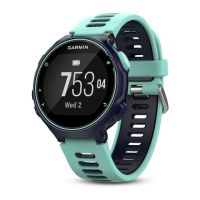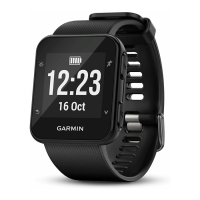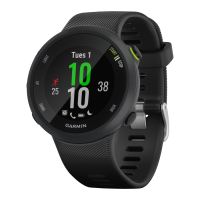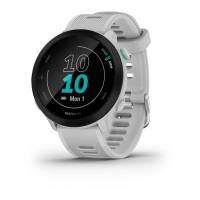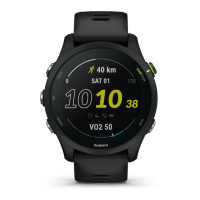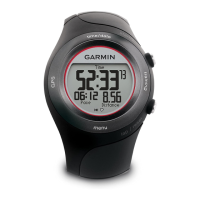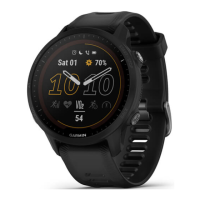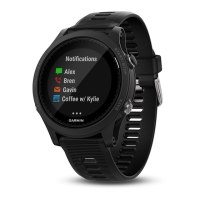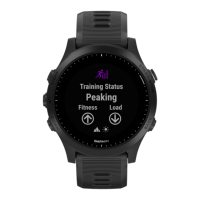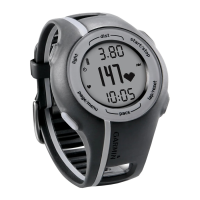device displays your performance condition score. For
example, a score of +5 means that you are rested, fresh, and
capable of a good run or ride. You can add performance
condition as a data field to one of your training screens to
monitor your ability throughout the activity. Performance
condition can also be an indicator of fatigue level,
especially at the end of a long training run or ride.
NOTE: The device requires a few runs or rides with a
heart rate monitor to get an accurate VO2 max.
estimate and learn about your running or riding ability
(About VO2 Max. Estimates, page 20).
Viewing Your Performance Condition
This feature requires wrist-based heart rate or a
compatible chest heart rate monitor.
1 Add Performance Condition to a data screen
(Customizing the Data Screens, page 40).
2 Go for a run or ride.
After 6 to 20 minutes, your performance condition
appears.
3 Scroll to the data screen to view your performance
condition throughout the run or ride.
Lactate Threshold
Lactate threshold is the exercise intensity at which lactate
(lactic acid) starts to accumulate in the bloodstream. In
running, it is the estimated level of effort or pace. When a
runner exceeds the threshold, fatigue starts to increase at
an accelerating rate.
For experienced runners, the threshold occurs at
approximately 90% of their maximum heart rate and between
10k and half-marathon race pace. For average runners, the
lactate threshold often occurs well below 90% of maximum
heart rate. Knowing your lactate threshold can help you
determine how hard to train or when to push yourself during
a race.
If you already know your lactate threshold heart rate value,
you can enter it in your user profile settings (Setting Your
Heart Rate Zones, page 11).
Performing a Guided Test to Determine Your Lactate
Threshold
This feature requires a Garmin chest heart rate monitor.
Before you can perform the guided test, you must put on a
heart rate monitor and pair it with your
device (Pairing Your
Wireless Sensors, page 37).
The device uses your user profile information from the initial
setup and your VO2 max. estimate to estimate your lactate
threshold. The device will automatically detect your lactate
threshold during runs at a steady, high intensity with heart
rate.
TIP: The device requires a few runs with a chest heart rate
monitor to get an accurate maximum heart rate value and
VO2 max. estimate. If you are having trouble getting a lactate
threshold estimate, try manually lowering your maximum
heart rate value.
1 From the watch face, select START.
2 Select an outdoor running activity. GPS
is required to complete the test.
3 Hold .
4 Select Training > Lactate Threshold Guided Test.
5 Start the timer, and follow the on-screen
instructions.
After you begin your run, the device displays each
step duration, the target, and current heart rate data. A
message appears when the test is complete.
6 After you complete the guided test, stop the timer and
save the activity.
If this is your first lactate threshold estimate, the
device prompts you to update your heart rate zones
based on your lactate threshold heart rate. For each
additional lactate threshold estimate, the device
prompts you to accept or decline the estimate.
Getting Your FTP Estimate
Before you can get your functional threshold power (FTP)
estimate, you must pair a chest heart rate monitor and power
meter with your device (Pairing Your Wireless Sensors, page
37), and you must get your
VO2 max. estimate (Getting Your VO2 Max. Estimate for
Cycling, page 20).
The device uses your user profile information from the initial
setup and your VO2 max. estimate to estimate your FTP.
The device will automatically detect your FTP during rides
at a steady, high intensity with heart rate and power.
1 Select UP or DOWN to view the performance
widget.
2 Select START to scroll through the performance
measurements.
Your FTP estimate appears as a value measured in
watts per kilogram, your power output in watts, and a
position on the color gauge.
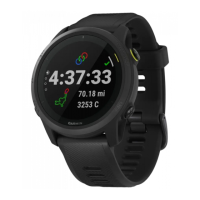
